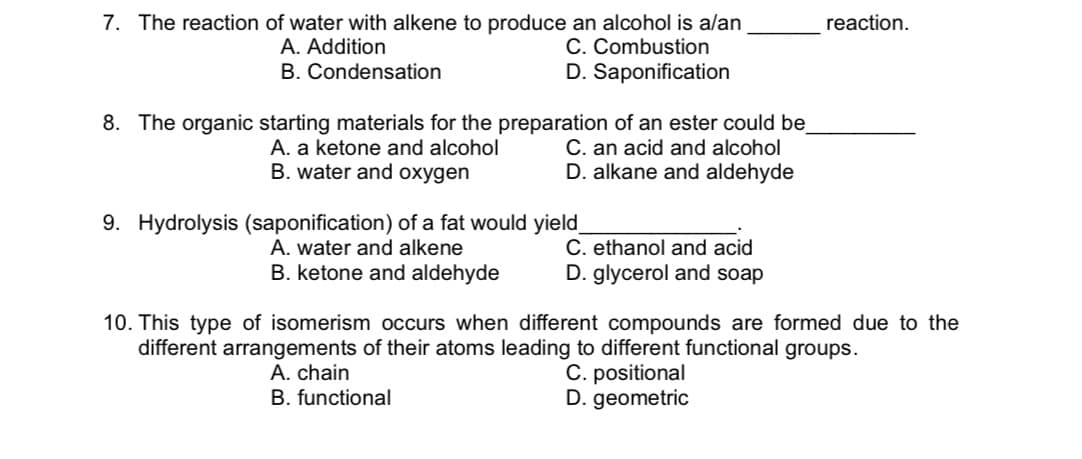7. The reaction of water with alkene to produce an alcohol is alan C. Combustion D. Saponification reaction. A. Addition B. Condensation 8. The organic starting materials for the preparation of an ester could be C. an acid and alcohol D. alkane and aldehyde A. a ketone and alcohol B. water and oxygen 9. Hydrolysis (saponification) of a fat would yield A. water and alkene B. ketone and aldehyde C. ethanol and acid D. glycerol and soap 10. This type of isomerism occurs when different compounds are formed due to the different arrangements of their atoms leading to different functional groups. A. chain B. functional C. positional D. geometric
7. The reaction of water with alkene to produce an alcohol is alan C. Combustion D. Saponification reaction. A. Addition B. Condensation 8. The organic starting materials for the preparation of an ester could be C. an acid and alcohol D. alkane and aldehyde A. a ketone and alcohol B. water and oxygen 9. Hydrolysis (saponification) of a fat would yield A. water and alkene B. ketone and aldehyde C. ethanol and acid D. glycerol and soap 10. This type of isomerism occurs when different compounds are formed due to the different arrangements of their atoms leading to different functional groups. A. chain B. functional C. positional D. geometric
World of Chemistry, 3rd edition
3rd Edition
ISBN:9781133109655
Author:Steven S. Zumdahl, Susan L. Zumdahl, Donald J. DeCoste
Publisher:Steven S. Zumdahl, Susan L. Zumdahl, Donald J. DeCoste
Chapter20: Organic Chemistry
Section: Chapter Questions
Problem 38A
Related questions
Question
Direction: choose the correct answer.

Transcribed Image Text:7. The reaction of water with alkene to produce an alcohol is alan
C. Combustion
D. Saponification
reaction.
A. Addition
B. Condensation
8. The organic starting materials for the preparation of an ester could be
C. an acid and alcohol
D. alkane and aldehyde
A. a ketone and alcohol
B. water and oxygen
9. Hydrolysis (saponification) of a fat would yield_
A. water and alkene
B. ketone and aldehyde
C. ethanol and acid
D. glycerol and soap
10. This type of isomerism occurs when different compounds are formed due to the
different arrangements of their atoms leading to different functional groups.
A. chain
B. functional
C. positional
D. geometric
Expert Solution
This question has been solved!
Explore an expertly crafted, step-by-step solution for a thorough understanding of key concepts.
This is a popular solution!
Trending now
This is a popular solution!
Step by step
Solved in 2 steps with 2 images

Knowledge Booster
Learn more about
Need a deep-dive on the concept behind this application? Look no further. Learn more about this topic, chemistry and related others by exploring similar questions and additional content below.Recommended textbooks for you

World of Chemistry, 3rd edition
Chemistry
ISBN:
9781133109655
Author:
Steven S. Zumdahl, Susan L. Zumdahl, Donald J. DeCoste
Publisher:
Brooks / Cole / Cengage Learning


Chemistry
Chemistry
ISBN:
9781305957404
Author:
Steven S. Zumdahl, Susan A. Zumdahl, Donald J. DeCoste
Publisher:
Cengage Learning

World of Chemistry, 3rd edition
Chemistry
ISBN:
9781133109655
Author:
Steven S. Zumdahl, Susan L. Zumdahl, Donald J. DeCoste
Publisher:
Brooks / Cole / Cengage Learning


Chemistry
Chemistry
ISBN:
9781305957404
Author:
Steven S. Zumdahl, Susan A. Zumdahl, Donald J. DeCoste
Publisher:
Cengage Learning

Chemistry: An Atoms First Approach
Chemistry
ISBN:
9781305079243
Author:
Steven S. Zumdahl, Susan A. Zumdahl
Publisher:
Cengage Learning

Chemistry for Today: General, Organic, and Bioche…
Chemistry
ISBN:
9781305960060
Author:
Spencer L. Seager, Michael R. Slabaugh, Maren S. Hansen
Publisher:
Cengage Learning
